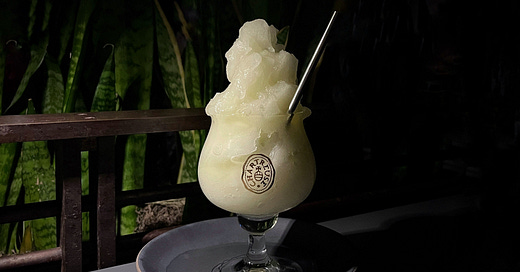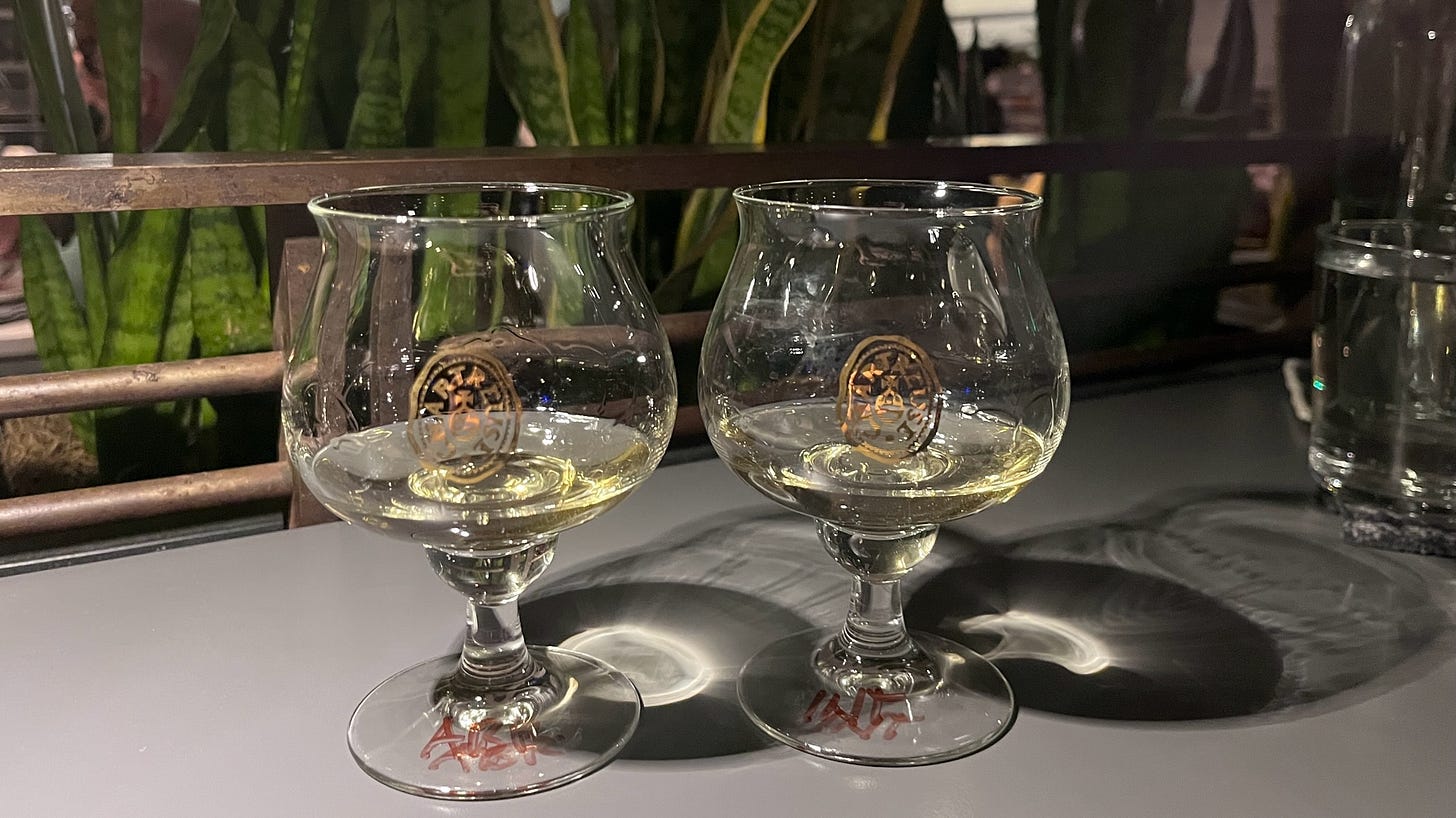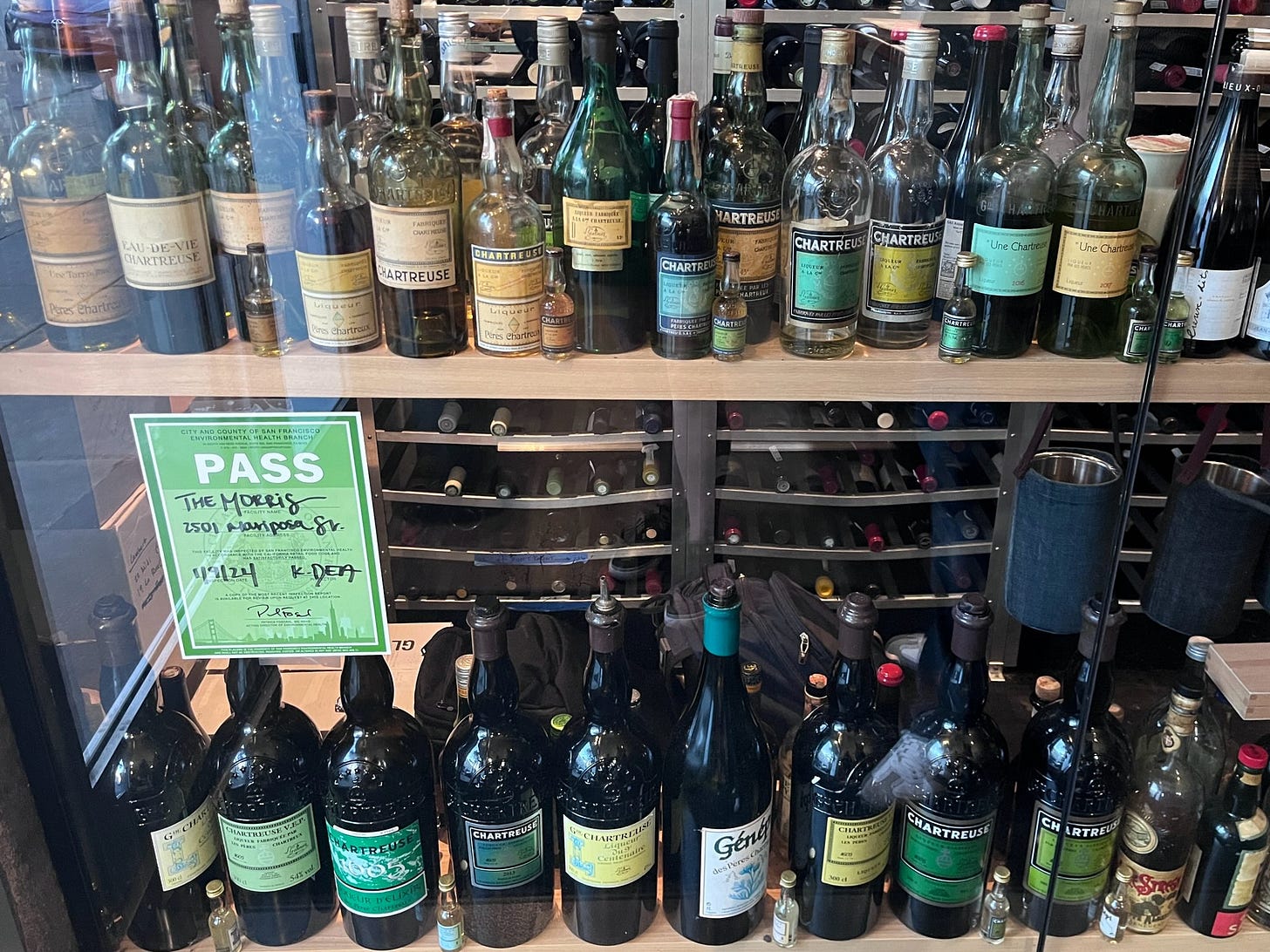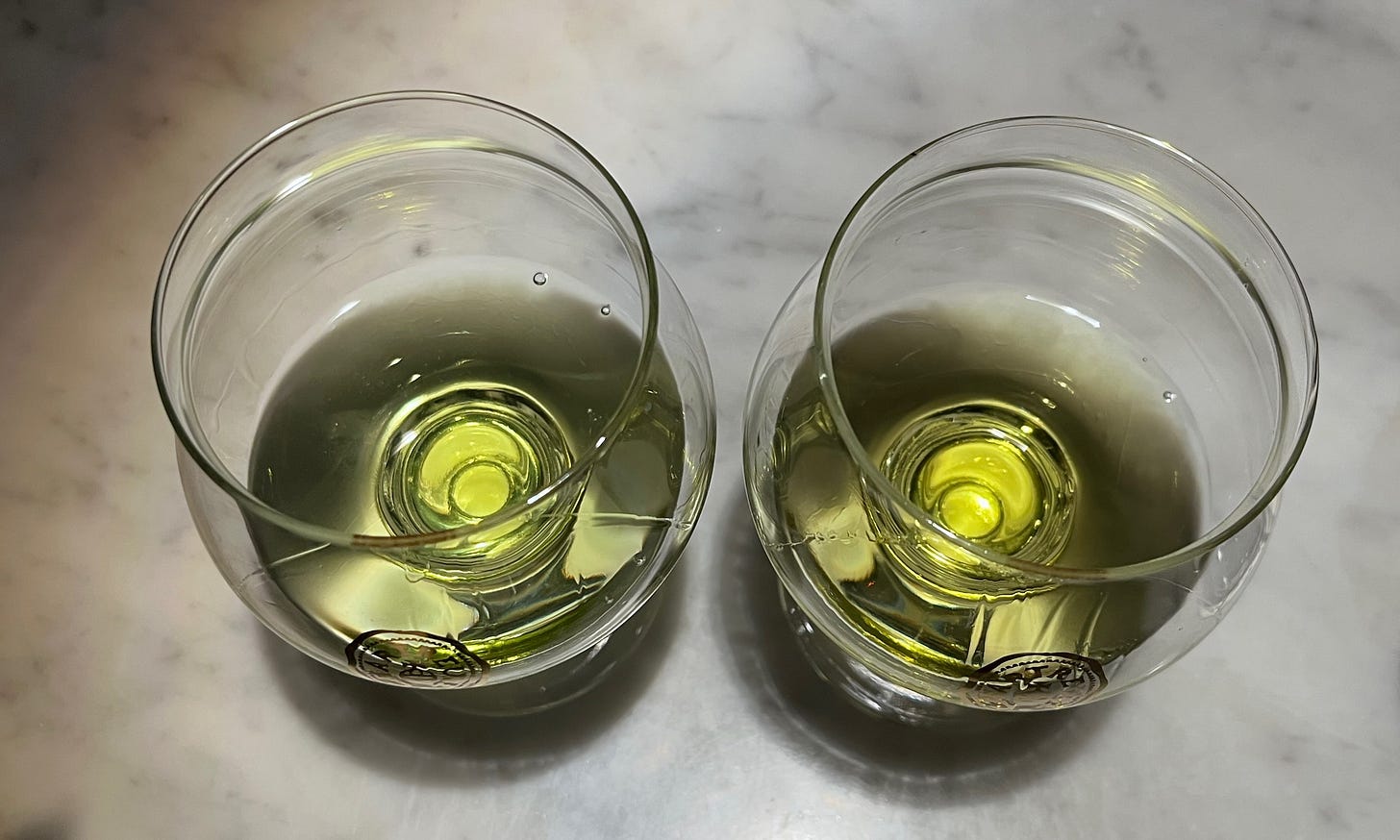This SF Restaurant Has One of the Best Chartreuse Collections in the Country
Come for the Chartreuse slushy, stay for a pour of the 1920s release produced in Marseille.
A genial man who I would later be informed was the GM at Trick Dog, where we were both hanging out on the same side of the bar (the drinking side, obvs), was giving me a rundown of restaurant and bar recommendations in the immediate area.
He was telling me about lesser-known places, the ones locals adore but are mostly off the lists that visitors to the city consult. I knew to listen up: San Franciscans gatekeep the city’s best spots, hard, so tips from a local are the only way to know what’s good. (The intentionality of this gatekeeping has been confirmed to me in several conversations I’ve had in the meantime with Bay Area natives.)
He named a low-key tapas place with a good sherry list, and mentioned the sister spot to the restaurant with notable cocktails I’d just come from. Then he mentioned a restaurant that offers a Chartreuse slushy. My ears perked up.
(Side note: This was the second time, five days into my two-week trip, that a bartender had mentioned Chartreuse slushies to me. Apparently I look like the sort of girl who would appreciate a Chartreuse slushy. This is correct. I am a little obsessed with the delicious, storied, culty, pricey herbal liqueur, and learning of a new and novel way to appreciate it is catnip to me.)
I closed out and wandered off in search of the magical icy concoction.
The restaurant, The Morris, looked low-key and almost diner-ish from the outside; I hadn’t even noticed it when I’d walked by earlier that day. Inside, it was essentially a typical small neighborhood restaurant: a dozen or so tables with a glass-fronted wine closet and an open kitchen in the front and a bar area in the back, where I was shown to a seat.
A server approached me with a menu. Without opening it, I said “I’ve been told you offer a Chartreuse slushy.” He smiled. “We sure do,” he said, and disappeared to put in my order.
He brought over a bottle of water. Even without its label, the bottle’s original purpose was obvious. “The water is even in a Chartreuse bottle?” I asked. “We like Chartreuse here,” he replied.
He delivered my slushy, mounds of the icy treat towering above the Chartreuse-branded glass. Its flavor was delicately herbaceous and pronouncedly citrusy; no ingredients were specified on the menu, but subsequent googling showed the bar had previously named them as green Chartreuse, tart lemonade, and palm sugar syrup, blended with ice in a Vitamix.
He then brought over the restaurant’s hefty wine list, opened to the Chartreuse page.
Chartreuse. Page.
This place was not messing around.
The list started with four different genepis (I hadn’t known the monks produced so many variations) and continued down to an offering bottled in Tarragona in 1912 or 1913 selling for $800 for a one-ounce pour. There were 26 options altogether, nearly half of which had been bottled before I was born.
I consider myself more knowledgeable about the brand’s history and offerings than most drinkers are, but this list revealed just how much I didn’t know. Chartreuse produced an eau de vie? A blueberry liqueur? What even is “Une Chartreuse”? The monks were in Marseille a century ago?
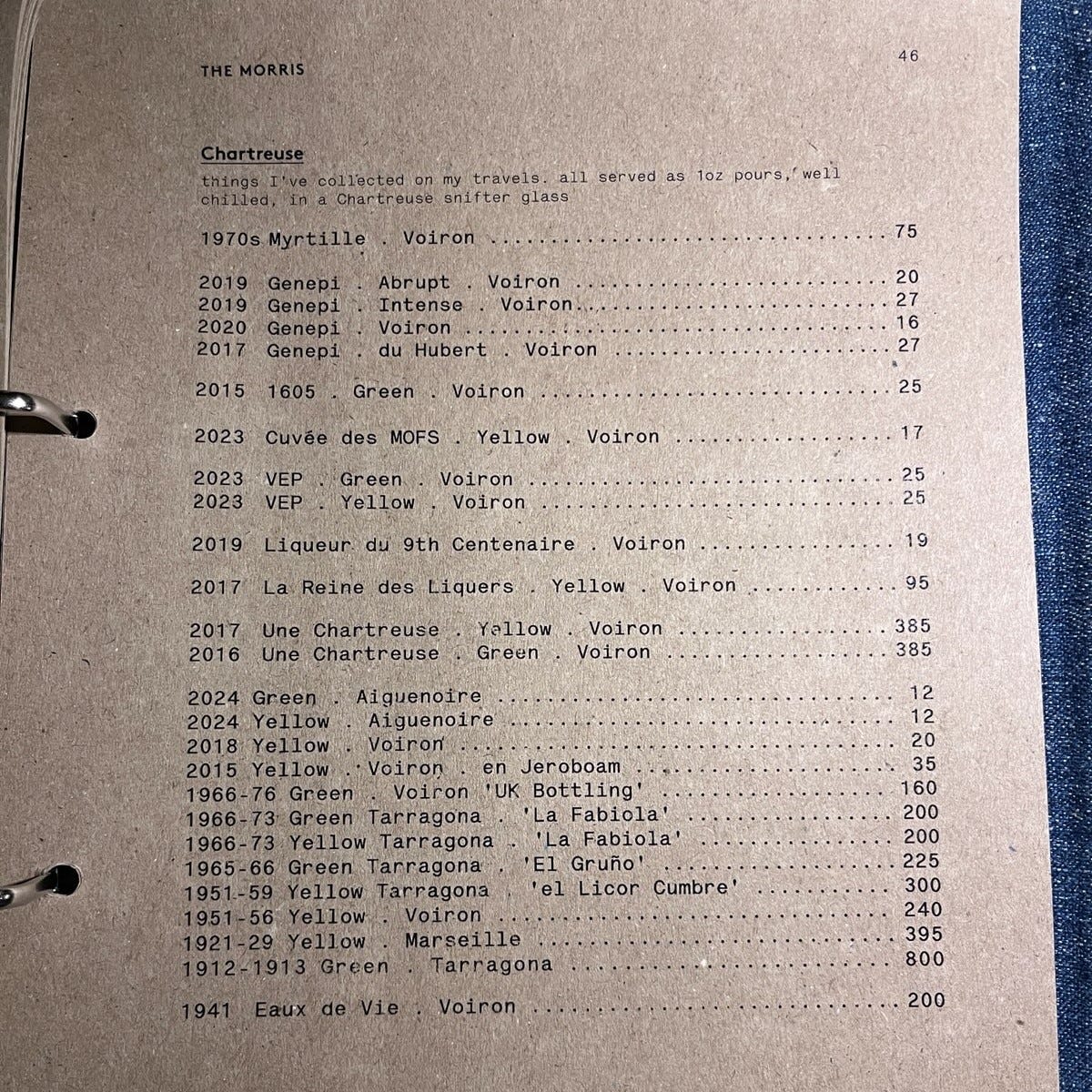
I drink a lot of Chartreuse. I take note of special bottles I encounter when I’m out, and ask about them when I can. I used to be a full-fledged regular at Pouring Ribbons, the now-shuttered NYC bar renowned for its Chartreuse collection, although it wasn’t until quite late in the bar’s lifespan that I could afford to partake in some of its rarer offerings.
I’ve only once before encountered a list that could rival The Morris’. It was at The Office, the vintage-spirits-focused bar in Chicago, and that list, although offering a greater range of years of production, was a bit shorter and less far-ranging in its options. I couldn’t, and still can’t, think of another place in the country with such a collection.
“This is insane,” I said to the server the next time he came around. He nodded. “There are some bottles here that aren’t even on the list,” he replied. I didn’t bother to ask him what they were, never mind how one might prove themselves worthy of access to those bottles, although of course I was curious. At a few hundred dollars a pour for even a mid-range option on the restaurant’s list, I knew reaching the exclusive status of accessing the truly special bottles wasn’t a realistic option for me. Why bring misery onto myself by learning of even more delicious things I couldn’t have?
I settled for pours of two different styles of genepi, Intense and Abrupt, to compare side-by-side.
And then the lovely woman sitting next to me convinced me to join her at the lindy hop gathering across the street. I had never before lindy hopped, but I guess I have, badly, now. This is what Chartreuse will do: Encourage you to make questionable decisions that turn into good stories afterward.
On my way out of the restaurant, I noticed something I’d failed to catch on the way in: the row of Chartreuse bottles just inside the door, lining the glass-fronted wine closet. Oh my. I hadn’t even heard of some of what I was seeing there—and the bottles weren’t empty. It reminded me of the storefront of Caves Bossetti in Paris—but with more and different types of the liqueur, and actual existing examples of the liquid within rather than shelves of old empties.
While there, I had posted a photo of the Chartreuse list to my Instagram stories. Reactions from friends much more Chartreuse-knowledgeable and -connected than I (by which I mean the brand has taken them on trips to the Chartreuse distillery in France) came in. “Wow. Wow. Wow.” read one. “I have never seen a Marseille listing before!” read another.
I returned to the restaurant a week later (this time without having visited two cocktail bars beforehand) for dinner, to try the duck I’d spotted on the menu during my first visit, which turned out to be its signature dish. (Deservedly so. I’m writing this nearly a month later and am still thinking about that duck.) I had the Chartreuse slushy again for dessert, plus a scoop of Chartreuse ice cream, and pours of the other two genepis on the list.
It's the sort of place where, if I lived in San Francisco and had unlimited funds for dining, I’d return every week.
The following evening, coincidence (and the influence of two very strong rum cocktails beforehand) found me dining at Sirene, The Morris’ brand-new sister restaurant in Oakland, where the other bartender had told me Chartreuse slushies were to be found. (I probably should’ve put together beforehand that the two restaurants were related, but did not.) It didn’t have the same emphasis on Chartreuse as its older sibling—recent-release Cardinale and Episcopale were the most interesting offerings, and I got a pour of each—but it did indeed have the slushy, plus a Chartreuse dessert with shiso and strawberries.
Disappointingly, I left the city about a week too early to dine at The Morris on “Chartreuse Day” (May 16, so designated to commemorate the year (1605) in which the Carthusian monks supposedly received the original recipe for the elixir). I’m told there was a special Chartreuse-focused menu with Chartreuse pairings offered; I would very much have liked to partake. (I had opera tickets in NYC that evening, so I’m not entirely heartbroken over missing it, but still.)
I’ve mentioned the restaurant to everyone I’ve encountered since my return who’s asked about my visit to SF; only one person (one of the aforementioned Chartreuse-insider folks) had heard of it. So this is me blowing up the nearly decade-old hidden gem; consider it my official endorsement. Go, next time you’re in town, and report back on the delicious things you drink. (The restaurant is renowned for its wine and madeira lists as well as Chartreuse.)
Just save some of that lovely green liquid for me. I’ll be returning as soon as I can.

